How to Sell Courses on Instagram (From a 7-Figure Creator)

Instagram is not just a photo-sharing app filled with inspirational captions. If used well, it could be your ticket to a full-time income.
Here’s the deal: You don’t need millions of followers to sell your courses on Instagram. Instead, you need to follow a proven system to turn those who follow you into paying students.
In this post, I show you how to sell your courses on Instagram and increase your earnings.
I’ve included the six actionable steps that helped me build a seven-figure business and attract over 100,000 followers on my Instagram profile.
How To Sell Courses On Instagram
For the sake of this tutorial, I will assume you’re starting from the beginning.
You might have somewhat of an Instagram following, but you’ve never promoted an online course or sold lots of things to your audience.
If you have, feel free to jump to step 4. If not, I suggest you go through each step in this guide.
Step 1: Build Your Foundation
Selling courses on Instagram starts with knowing who your ideal student is.
As the famous (paraphrased) saying goes, when you market to everyone, you market to no one.
This has never been truer than today. Unless you find “your people”, everyone on the internet could be your target audience. And when you have a message that broad, it will be so diluted no one will take notice.
To identify your ideal student, start by considering their demographic details.
What is the:
- age
- location
- educational background
- occupation
…of your ideal person?
Next, consider their beliefs, values, and goals. Knowing these three factors (a few of what’s known as psychographic behaviors) helps you shape and market your product.
After, consider their interests and hobbies. This will help you create content solutions that will get them the desired results (more on this in the following sections). These solutions will be part of the free and paid content you offer.
Then, consider your competitors. Find the people who are crushing it in your industry. Dig deep and discover the pain points they are addressing. Also, consider their strengths and weaknesses.
What do they do well in marketing and sales? What areas could they improve in? This information will help you find spots where your products, services, and message can fit in.
Finding your unique value in the marketplace is essential. You don’t want to start from scratch with a brand-new message. It takes lots of time to find what works.
At the same time, you don’t want to offer the same thing everyone else is. This guarantees your message gets lost in a sea of competitors.
Establishing your unique value proposition is the one thing that sets you apart from everyone else.
Step 2: Set Up Your Content Strategy
By now, you should understand how to position yourself better and different from your competitors.
The next step to selling online Instagram courses is to develop your content strategy. Content is at the heart of any social network, and Instagram is no different.
To make things simple, let’s consider content from 3 different angles.
Sharing It
Instagram offers differnet ways to share your content. These include:
- Posts
- Reels
- Stories
- Highlights
- Shorts
- Notes
- Live
I suggest you find the one (or two) you like most and run with them. Trying to focus on too many methods will overwhelm you. The result?
You give up before getting started. And that’s the last thing I want for you.
Content Pillars
What should you be posting about?
By answering this question, you’ll identify key themes to post about. These key themes will become your ‘content pillars’—that is, the topics you become famous for.
In my case, some of my content pillars include:
Since I’ve created lots of content about these pillars, my audience resonates with them. I can also post about sub-topics within these pillars and get a great response.
However, if I create content unrelated to these pillars, I find my engagement goes down the drain.
Content Format
Finally, you should also consider the content format. Here are some ideas:
- Educational content (including tutorials and tips)
- Behind the scenes
- Inspirational stories from studies (case studies, testimonials)
- Q&A sessions
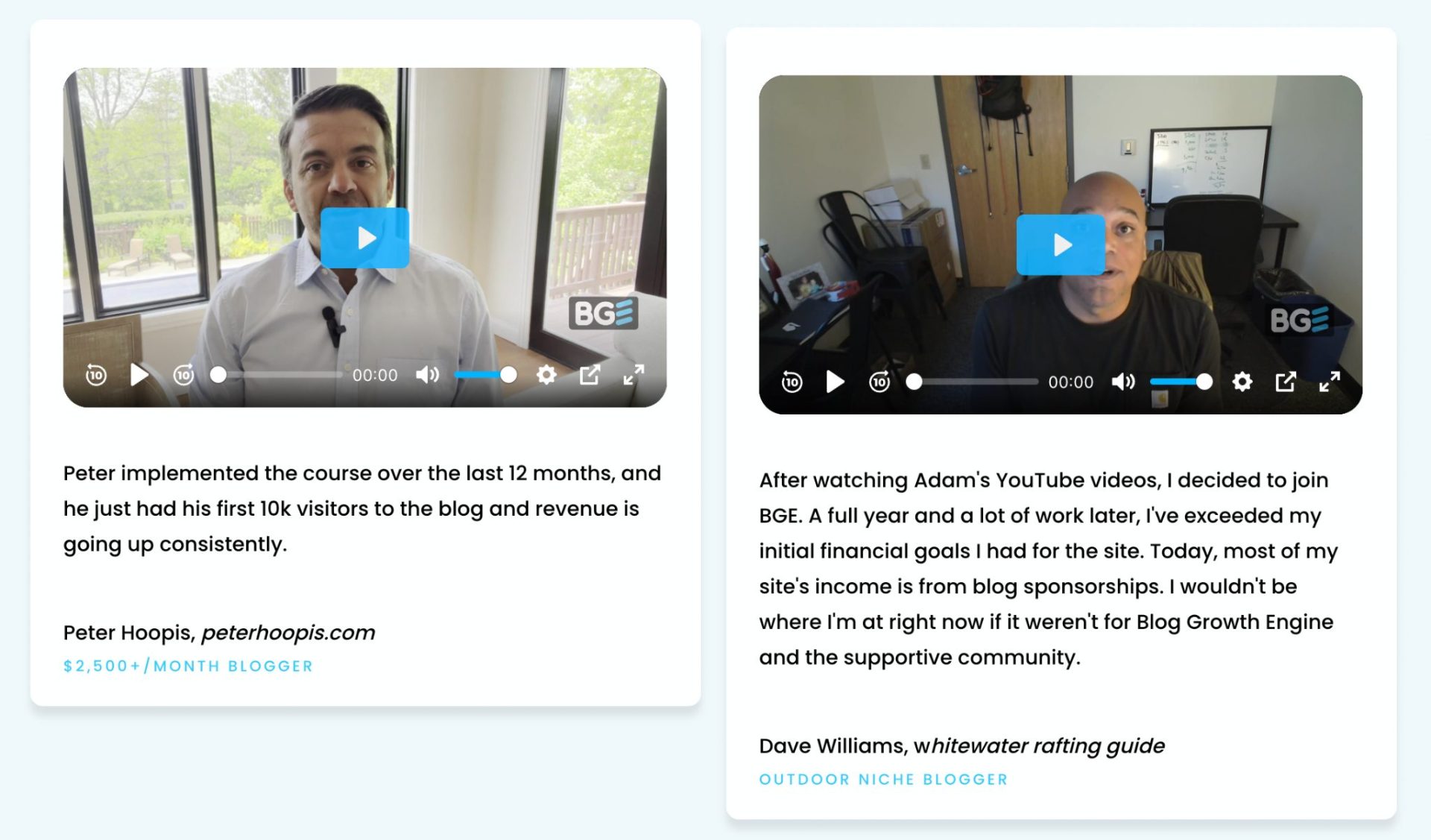
Examples of inspirational content that can be turned into Instagram posts
The content format that makes the most sense generally depends on your business and the types of courses you sell.
Referring to the above screenshot, I can use testimonials from BGE students as the basis for the content I produce.
Moreover, I could create behind-the-scenes posts showing the process of building our courses, from the initial concept to the final product.
Additionally, I can share educational content through tutorials or tips related to the pillars of our business.
There are plenty of ways to use different formats to create content.
Bringing It All Together
When you decide on the three above factors, it’s time to build your content strategy.
And this is where a content calendar comes in.
Having a content calendar is crucial at this point. It will help you know:
- What you’re posting
- When you’re posting it.
You don’t want to wake up every day and try to figure it out. Doing so is a great way to get overwhelmed quickly and give up selling your courses on Instagram.
A content calendar can be simple or complex or somewhere in between. At its core, it looks like this (this is an example of a weekly content calendar posting 3 times a day):
|
Day |
Time |
Type |
Topic |
Content Description |
|---|---|---|---|---|
|
1 |
9:00 AM |
Post |
Blogging |
– Inspirational quote about writing or blogging. |
|
1:00 PM |
Reel |
Artificial Intelligence |
– Infographic explaining a basic AI concept. | |
|
6:00 PM |
Story |
Affiliate Marketing |
– Share tips for beginners in affiliate marketing. | |
|
2 |
9:00 AM |
Short |
YouTube |
– Share a teaser of an upcoming YouTube video. |
|
1:00 PM |
Post |
Blogging & YouTube |
– Discuss how blogging and YouTube can complement each other. | |
|
6:00 PM |
Live |
AI & Affiliate Marketing |
– Explain how AI can revolutionize affiliate marketing. | |
|
3 |
9:00 AM |
Post |
Artificial Intelligence |
– Post about the impact of AI on daily life. |
|
1:00 PM |
Reel |
Affiliate Marketing |
– Post a success story of someone successful in affiliate marketing. | |
|
6:00 PM |
Story |
Blogging |
– Share a success story or case study of a successful blog post. | |
|
4 |
9:00 AM |
Short |
YouTube |
– Post a YouTube video snippet with a link to the full video in bio. |
|
1:00 PM |
Post |
Artificial Intelligence |
– Discuss the future of AI and engage with the audience. | |
|
6:00 PM |
Live |
Blogging & YouTube |
– Benefits of YouTube for increasing blog traffic. | |
|
5 |
9:00 AM |
Post |
Affiliate Marketing |
– Demystify a common myth about affiliate marketing. |
|
1:00 PM |
Reel |
AI & Affiliate Marketing |
– Share tools that use AI to improve affiliate marketing efforts. | |
|
6:00 PM |
Story |
Blogging |
– Behind-the-scenes look at blogging setup or workflow. | |
|
6 |
9:00 AM |
Short |
YouTube |
– Share a personal story about your YouTube journey. |
|
1:00 PM |
Post |
Artificial Intelligence |
– Asking your audience for their views on AI and affiliate marketing. | |
|
6:00 PM |
Live |
Blogging & YouTube |
– Share a case study of a successful content strategy involving both social media platforms. | |
|
7 |
9:00 AM |
Post |
Reflection and Engagement |
– Share what you’ve learned from focusing on these topics over the week. |
|
1:00 PM |
Story |
Reflection and Engagement |
– Host a Q&A session on Instagram stories about the week’s topics. | |
|
6:00 PM |
Live |
Reflection and Engagement |
– Thank your followers for their engagement and preview next week’s content. |
The more structured you get at this stage, the better content you produce. It also increases the number of students you’ll enroll in the courses you sell on Instagram.
Step 3: Start Posting
Once you set up your content calendar, it’s time to start creating and posting content. This step is pretty self-explanatory.
What’s important is that you engage with your audience after you post.
If people leave you comments, reply. Answer any questions they might have.
Also, ask them further questions. These people are the best candidates to offer feedback on your content and future courses.
The more detailed you understand their pain points and the solutions they’re looking for, the better courses you can create.
Instagram also offers features like poll creating and asking questions in stories.
Use these features for further market research. Consider what your audience (i.e., followers) say and use that information to create more targeted and valuable content.
Step 4: Create and Align Your Course
This is where the real fun stuff begins. It’s also a process you can’t start from day one. It takes time until you’ve built an audience and a good understanding of their needs.
How many followers should you have before starting to sell a course?
While this is a common question, it’s the wrong now. It’s never about followers. Many accounts with “a small number of followers” have much more influence than those with millions.
While it’s a nice piece of information, having followers just for the number is a vanity metric. What’s more important is how engaged the people that follow you are.
Even more importantly, how valuable do they find the content you post?
Do they know, like, and trust you and your content?
While some of these questions are tough to answer, thinking about them is essential as you build your course.
Let’s now consider the how-to part of building your course.
Create Solutions to Pain Points
The easiest way to create your course is to realize that your followers have problems. Your course should help solve these problems.
Let’s consider my course, Blog Growth Engine.
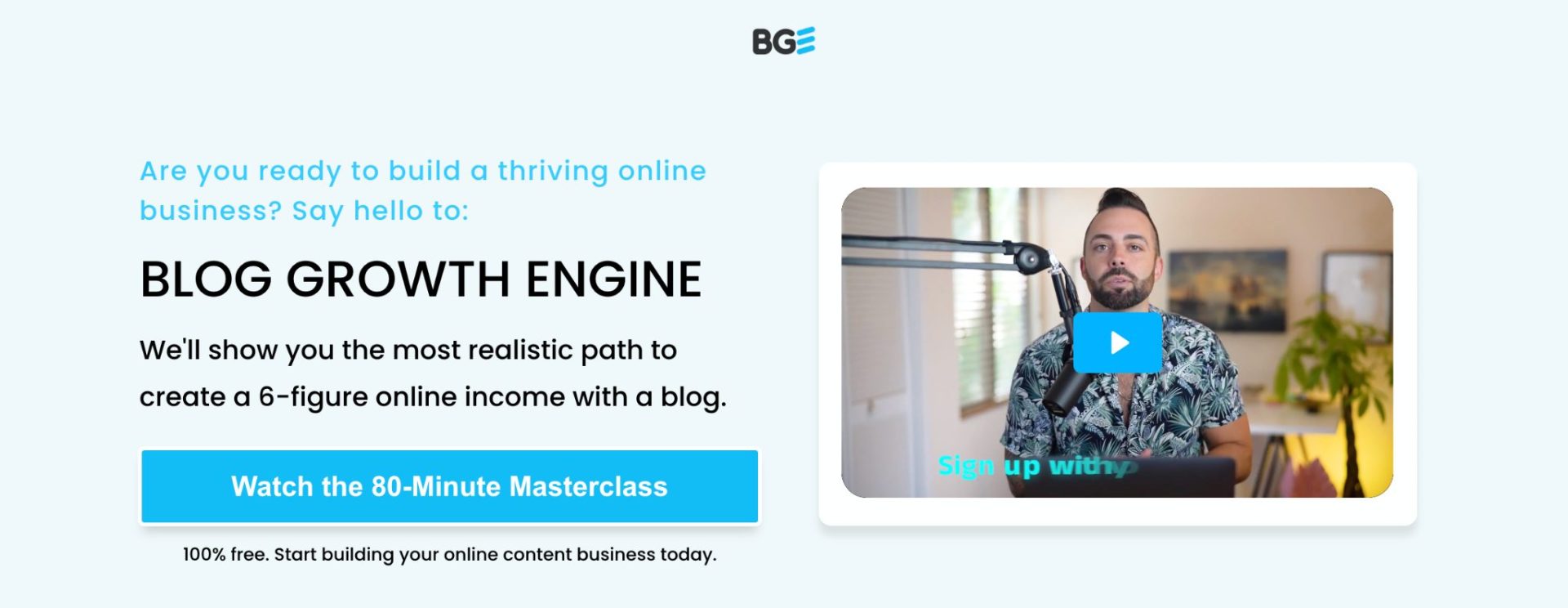
Amongst other things, I know and understand:
- many people want to make a side income.
- a blog is a great way to hit this goal
- people find starting and maintaining a blog difficult. There are a lot of moving pieces.
- Google updates happen often. It’s tough to stay on top of them and ensure your blog keeps its rankings.
All this to say, there are a lot of elements my target audience needs help with.
As I started posting more content, I saw which posts got the most traction. These were the posts people engaged with and which got the most questions.
I then built the course contents based on three things:
- The target market information
- The feedback I got on my posts
- My long-term expertise.
As I built up my courses, the aim has always been to offer clear, actionable solutions to my students.
Side note: The above also means that I update my content over time, staying ahead of the curve. How often you update your course content depends on your topic.
With some topics, there are new developments very often. With others, things are (more) evergreen and don’t require much change.
Unique Value Proposition
Unless you’re in some small, super-niched market, competitors are already selling similar courses to the one you want to sell.
In other words, people are already buying information, products, and services from other people.
In step 1, I asked you to consider your competitors. This research will help you create a course that offers a unique value proposition to these competitors.
Here are some further questions to help you pinpoint your unique value proposition:
- What makes your course different from others in the market?
- How can you provide a unique approach to this topic?
- What additional benefits or features does your course offer that others do not?
- How does your course solve a problem or meet a need that other courses do not address?
Validate Your Assumptions
What’s one of the worst things you can do when selling a course?
Spending weeks, months, or even years building a huge library of information. You keep adding more and more stuff because you know your (future) audience will benefit from it. After spending (or wasting) so much time, you publish your course. The result?
Crickets.
People don’t want what you created.
This happens more often than you think. As course creators, we get attached to our products as if they were our children.
The problem is that we are not our students. It’s only our students who define the success or failure of a course.
The solution to this is simple (but not easy). It is to validate your assumptions – and do this often.
Before you launch a course, speak to and get feedback from your audience. Tell them you will release a course within the next X days or months. Share details about its content with them. Explain how this content will help them solve their problems.
Then, listen to the response.
Does your content resonate with your audience? Do they get excited by the stuff they’ll be able to learn and accomplish?
It’s also a great idea to have a waiting list. Offer people a future discount if they sign up to get notified when you release your course.
The number of people who sign up is a good indication of your course’s future success.
Not everyone who signs up for a pre-launch waiting list will convert into an actual purchase. However, it’s an excellent way to see the initial response.
You can also offer your Instagram users a condensed version of your course. As you’re building your course, this “beta group” will receive it for free or at a reduced price in exchange for their honest feedback.
You’re trying to gauge whether you’re heading in the right direction. Is what you’re focusing on a good idea or do you need to make adjustments?
Step 5: Capture Leads & Engage Them
Now that you’re producing content regularly and have a course you’re building, let’s talk about leads.
Leads are those in the stage between “strangers on Instagram” and “paid students”.
They (somewhat) know what you do and (hopefully) understand you can help them.
You offer them even more valuable content to bridge the gap between their current state and the next stage (getting them to become students).
But let’s first get into a quick definition to ensure we’re on the same page.
What Are (Engaged) Leads?
Alex Hormozi defines a lead as someone you can contact.
He goes further and defines an engaged lead as the type of person you want to pursue.
This is someone you can contact that “has indicated an interest in the stuff you sell”.
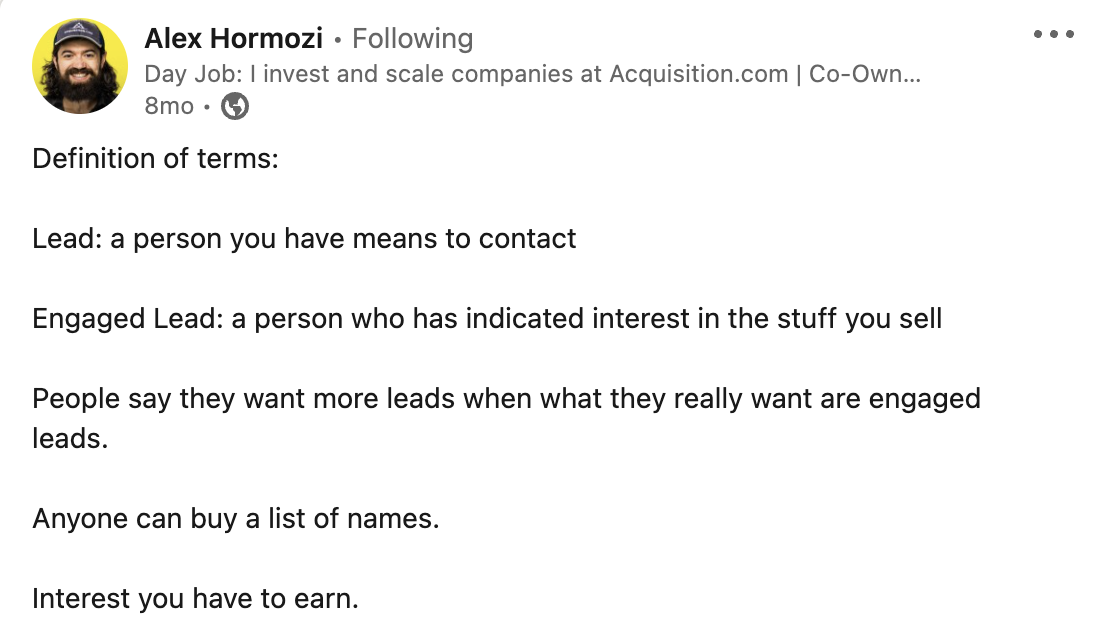
Source: linkedin.com
You get engaged leads by continuing to provide value – over and over again.
You want people to conclude that your stuff can really help them. Even better, you want them to think:
“If your free stuff is so valuable, I can’t even imagine what your paid stuff is like.”
When people arrive at this conclusion, it makes it an easy sell to give you money and become a paid student.
Ways to Capture Leads on Instagram
There are many ways to get people to give you their contact information on this social platform.
Link in bio
The easiest way to capture leads is to have a link in your bio.
Use a landing page builder to set up a website where you give people something of value in exchange for their contact details.
You can also post this link in your Instagram stories. This gives people a direct way to get to your course landing page from the stories you post.
Instagram ads
Running Instagram ads is another way to get people to show an interest in your course.
You can target your Instagram followers directly. This ensures you reach the people who are most interested in your content.
At the same time, you can also run ads for people with specific interests, demographics, or psychographics.
This is why the exercises at the beginning (in Build Your Foundation) were crucial.
Auto DM
You can also ask people to send you direct messages when you make posts.
This “traditional way” of starting a conversation is a great place to build a deep relationship with people before asking them to give you money.
The problem is that this is a very manual process. You will end up glued to your phone, sending direct messages and giving people your landing page link—not fun at all.
However, there’s a better way.
Different software solutions allow you to send people your landing page link automatically.
All people must do is comment on your Instagram post with a specific word you define.
Once they do, the integrated software solution does all the work. It will ‘realize’ someone asked for specific information and send them a message sequence that includes your landing page link (or anything else you want to share).
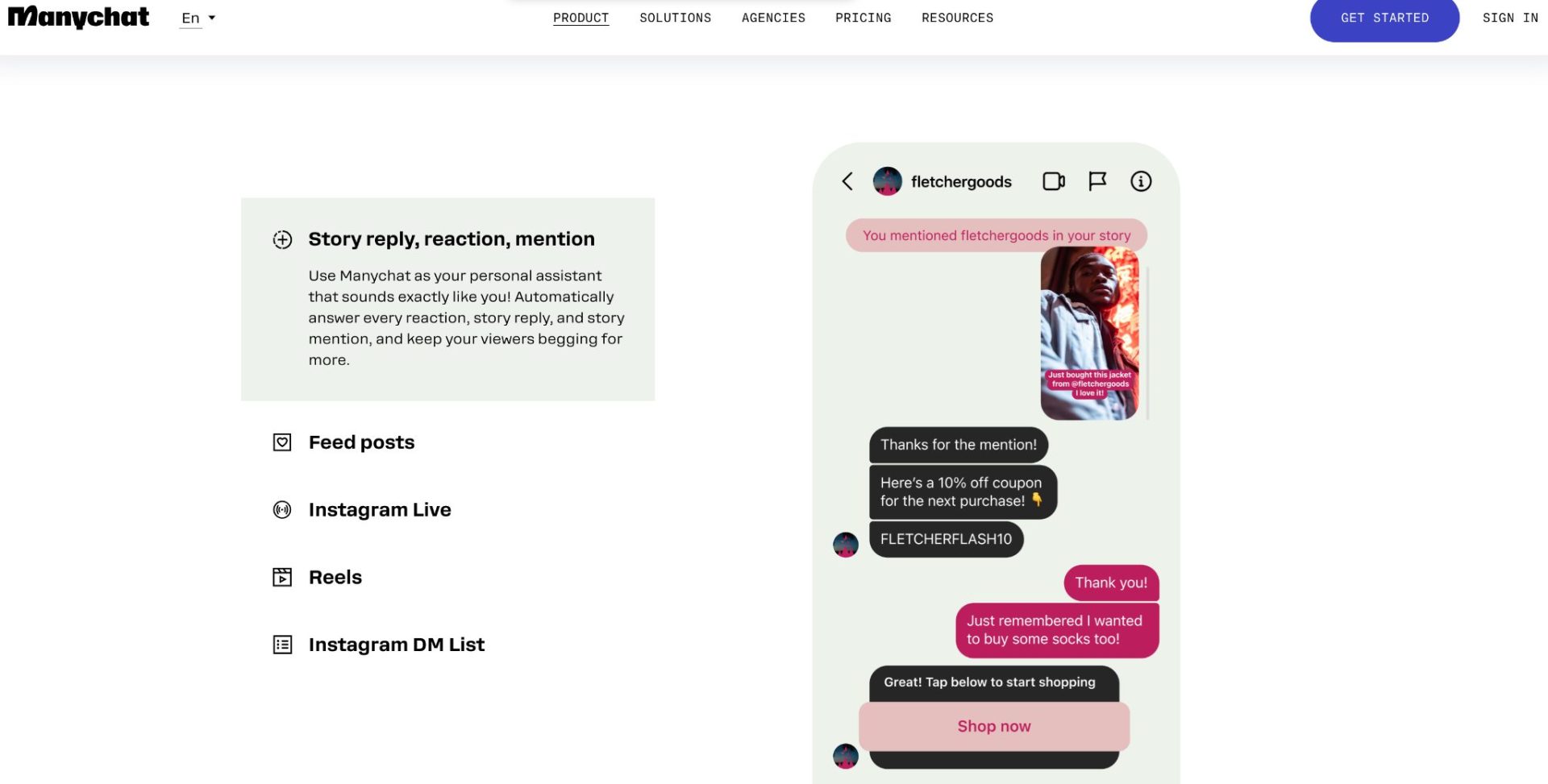
Source: manychat.com
For example, with ManyChat, you can trigger the start of a messaging sequence when someone reacts or replies to your content.
Here’s an example:
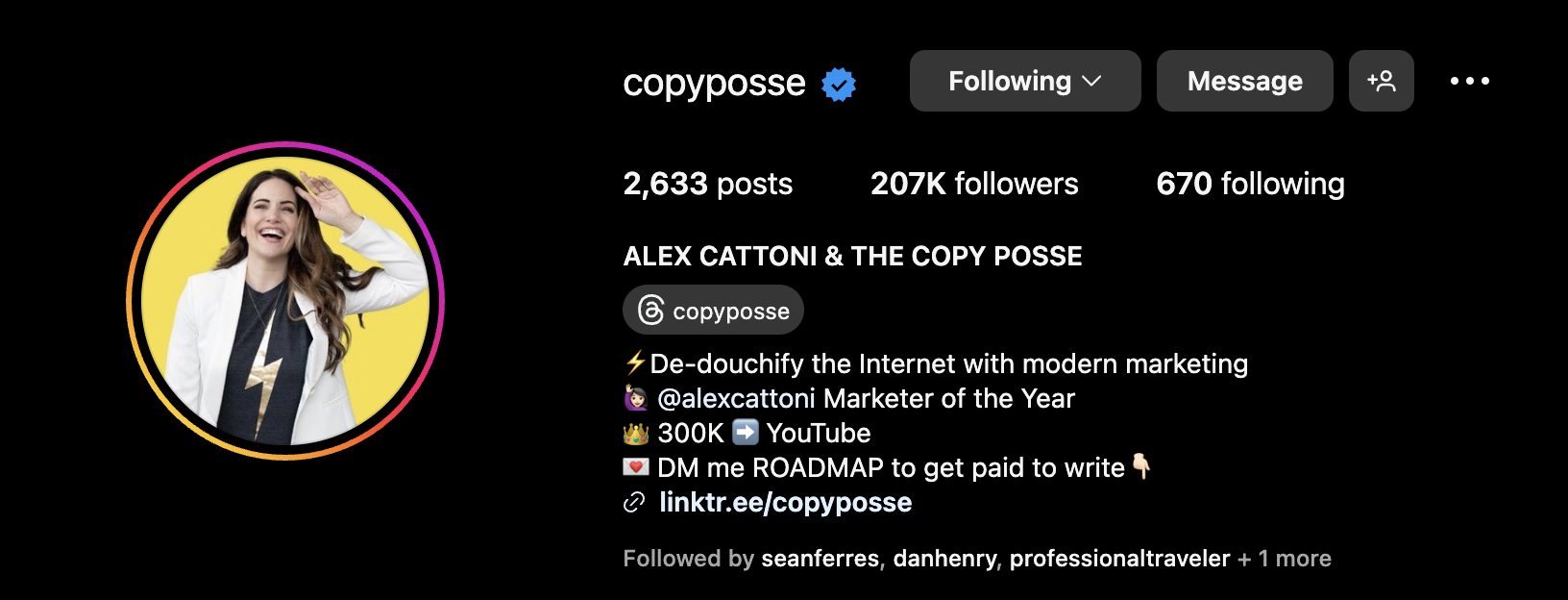
Source: instagram.com
Here’s the answer one gets when they DM the specified word to the above content creator:

Here’s another example:
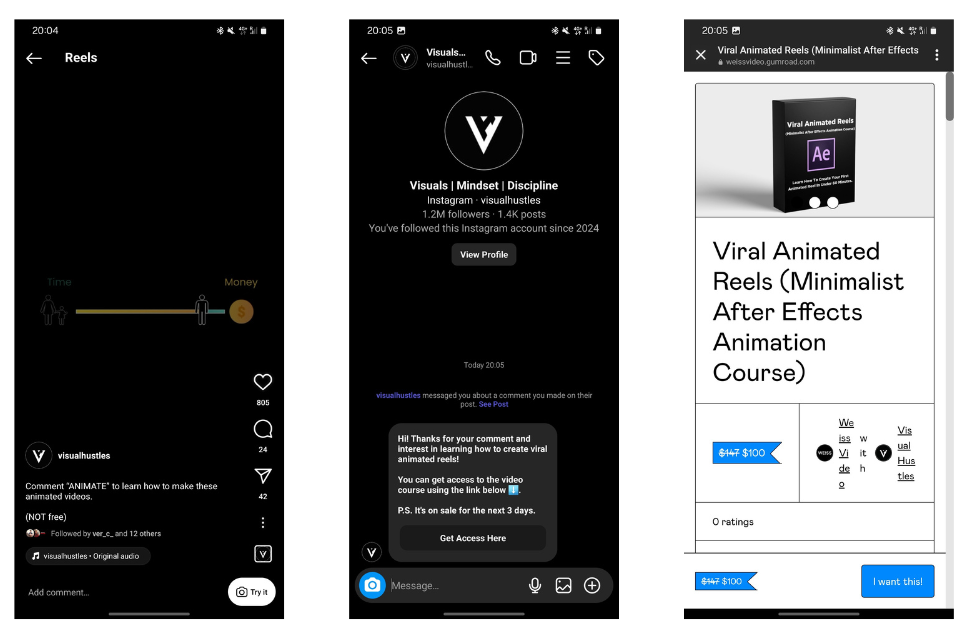
Source: instagram.com
You’ll receive a message with a call to action once you comment on a specific post with the given word.
Here’s another one:
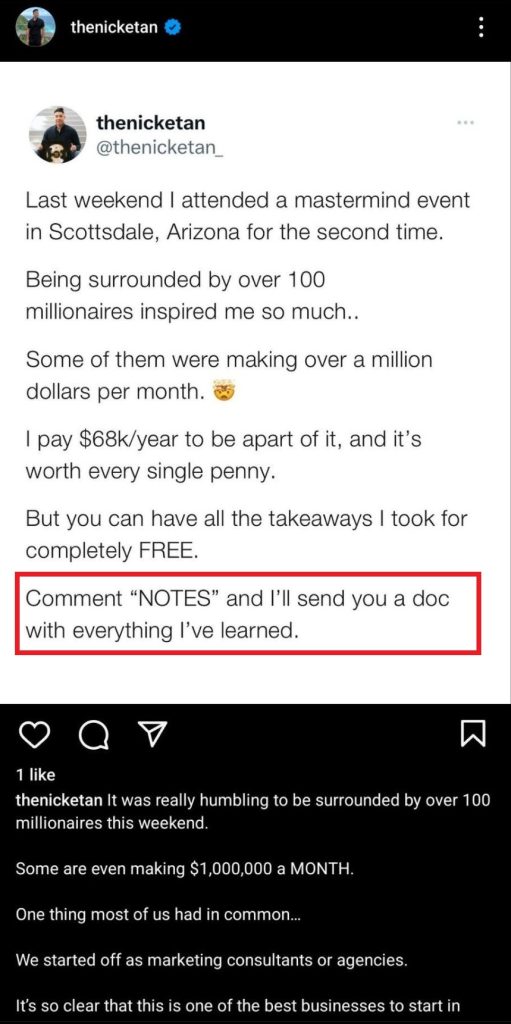
Source: instagram.com
Nifty, right? And everything happens automatically without the creator lifting a finger.
Step 6: Online Course Promotion
At this stage, you have a contact factory going.
You post free stuff on your Instagram regularly that informs people of:
- Your expertise
- What you do
- How you can help them
Some people want more information. You provide these people with a lead magnet. They give you their contact information in exchange for this valuable information.
You also have a paid course that people can buy if they want to learn more about you and your expertise.
But what if you want to promote your online course even more?
Here are some further ideas.
Organic Growth Strategies
Organic growth is always a good idea. It’s a great way to provide value, stay top of mind, and see what people engage with most.
However, you don’t want to JUST post about your course. In other words, don’t only tell people about why they should pay you money.
At the same time, if you never mention you have a paid course, people won’t know about it. And if it’s the right fit for them (and they’re ready to buy), you would lose out on potential customers.
What you could do is a mix of “share in public, sell in private”.
If someone constantly likes and comments on your content, there’s nothing wrong in directly messaging the person. You ask them where they’re at in their business or personal journey (depending on your niche) and what they need help with.
If your course can help with their problems, you can suggest it as a possible solution.
You could also collaborate with other creators in your niche.
Finding allies (rather than direct competitors) is essential. You don’t want to compete with people who are after the same persona you’re selling to.
For example, if you’re a fitness trainer, you might go to chiropractors and nutritionists and discuss potential collaborations. Working together with other experts in your field can bring in new audiences.
It also provides a valuable exchange of knowledge and skills.
Paid advertising
You can also invest money into selling your online courses on Instagram since Meta (the company behind Instagram) offers an advertising platform.
The idea is that you pay money to put your ad in front of the right people. Your job is to make more money from selling your courses than you spend to get in front of these customers.
For example, if you sell a course for $97 and it takes you $77 to get a customer, you’re making a profit while getting a paid customer.
Anything you sell to this customer in the future is pure profit. You won’t have to pay anyone else to get this customer’s details again.
To get started with paid ads, Instagram advertising can be a great channel for your business.
Conclusion
Selling online courses on Instagram is about offering value while building trust with your audience.
The good news is that your market will let you know if you’re moving in the right direction. This will become clear as you get more customers through your Instagram.
If you’re ready to get started, follow the steps above. Remember that every step in the right direction is a step closer to your goal.





